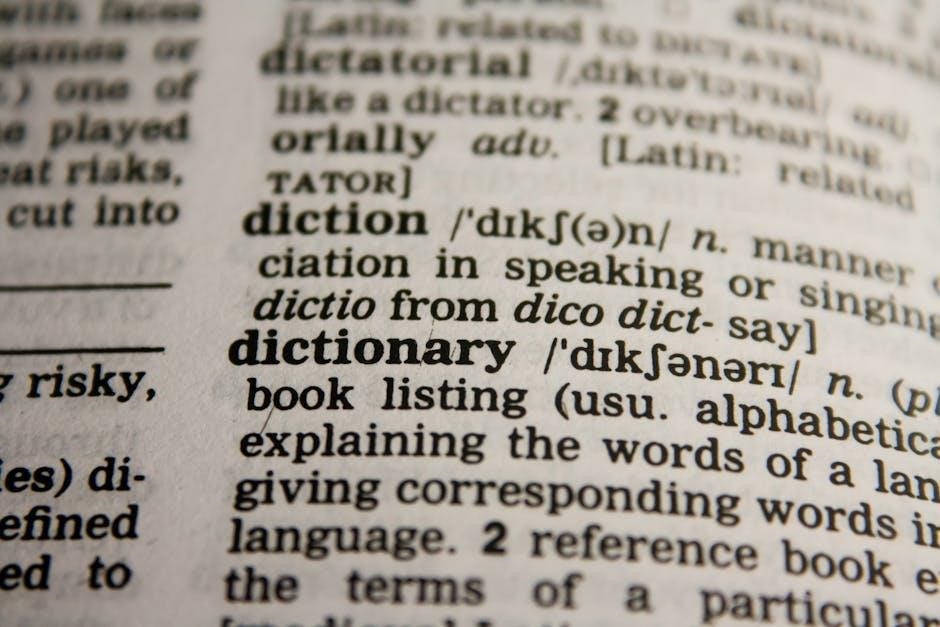Tier 3 vocabulary consists of specialized, subject-specific words essential for academic success․ These terms are often discipline-relevant, such as “herbivore” in science or “aesthetically” in Physical Education․ Educators can access PDF guides listing Tier tailored to specific units, like landforms in science, to support targeted instruction and curriculum alignment․ These resources help teachers identify and teach critical vocabulary, ensuring students grasp key concepts across various subjects․
Definition and Scope of Tier 3 Vocabulary
Tier 3 vocabulary refers to specialized, discipline-specific words that are critical for understanding complex concepts within a particular subject area․ These words are not commonly encountered in everyday language but are essential for academic success․ They are often tied to specific fields, such as science, literature, or physical education, and are typically identified from curriculum standards and educational resources․ For example, terms like “herbivore” in biology or “aesthetically” in Physical Education are classified as Tier due to their subject-specific nature․ These words are rarely used outside their respective disciplines, making them less familiar to students but highly significant for mastering content knowledge․ Educators often create Tier 3 vocabulary lists, such as PDF guides, to help students acquire these specialized terms effectively․ Unlike Tier 1 and Tier , Tier 3 vocabulary requires explicit instruction and contextual learning to ensure comprehension․
Importance of Tier 3 Vocabulary in Academic Success
Mastery of Tier 3 vocabulary is crucial for academic success, as these specialized words are central to understanding complex concepts within specific subjects․ Students who grasp Tier 3 terms are better equipped to engage with challenging texts, participate in academic discussions, and perform well on assessments․ These words often represent key ideas in disciplines like science, literature, and physical education, making them indispensable for subject-area proficiency․ For example, understanding “herbivore” in biology or “aesthetically” in Physical Education enables students to grasp fundamental concepts and apply them in various contexts․ Without familiarity with Tier 3 vocabulary, students may struggle to comprehend advanced materials and fall behind in their studies․ Educators emphasize the importance of explicitly teaching these words, often through resources like PDF guides, to ensure students can access and master critical content․ Tier 3 vocabulary thus serves as a bridge between foundational knowledge and advanced academic achievement․

Characteristics of Tier 3 Vocabulary
Tier 3 vocabulary includes specialized, subject-specific words that are less common but central to specific disciplines, requiring explicit instruction and often found in PDF guides for educators․
Subject-Specific Nature of Tier
Tier are highly specialized and specific to particular subjects or disciplines․ These terms are not commonly encountered in everyday language but are crucial for understanding key concepts within a specific field․ For example, in science, words like “herbivore” or “landforms” are essential, while in English, terms like “argue” or “atmosphere” are critical․ Similarly, in Physical Education, words like “aesthetically” or “criteria” hold specific meanings․ These subject-specific words are often identified and compiled into lists, such as those found in PDF guides for educators, to ensure targeted instruction․ Unlike Tier 1 or Tier 2 vocabulary, Tier are not universally applicable and require explicit teaching within their respective contexts․ Educators rely on these lists to identify and prioritize the most relevant Tier 3 terms for their students, ensuring they master the language necessary for academic success in their specific areas of study․
Examples of Tier 3 Vocabulary Across Disciplines
Tier 3 vocabulary words are often discipline-specific and vary significantly across subjects․ For instance, in science, words like photosynthesis, oxidation, and hypothesis are essential․ In literature, terms such as symbolism, imagery, and theme are critical for analysis․ In mathematics, words like hypotenuse, function, and variable are fundamental․ History classes might include terms like chronology, era, and narrative․ These examples illustrate how Tier are tailored to the specific content and skills required in each subject area․ Educators often compile these words into lists, such as those found in PDF guides, to ensure students gain mastery over the language necessary for academic success․ These lists help teachers design targeted lessons and assessments, ensuring students understand and can use these terms effectively in their respective fields of study․

Sources for Tier 3 Vocabulary Lists

Sources for Tier 3 vocabulary lists include curriculum standards, educational publishers, and PDF guides from organizations like CCSS and NGSS․ These resources provide discipline-specific terms for targeted instruction․

Curriculum and Standards-Based Lists
Curriculum and standards-based lists are essential sources for Tier 3 vocabulary, as they align with specific educational frameworks and learning objectives․ These lists are often derived from national and state standards, such as the Common Core State Standards (CCSS) for English Language Arts and the Next Generation Science Standards (NGSS) for science․ They are organized by grade level and subject area, ensuring relevance and applicability to classroom instruction․ Many of these lists are available in downloadable PDF formats, making them easily accessible for educators․ For instance, the CCSS provides appendices with grade-specific vocabulary for literature and informational texts, while the NGSS highlights discipline-specific terms in science and engineering․ These resources are valuable because they are vetted by educational experts and aligned with assessments and textbooks, ensuring consistency across curricula․ Educators can use these lists to identify high-utility Tier and design targeted vocabulary instruction․
Discipline-Specific Vocabulary Resources
Discipline-specific vocabulary resources are tailored to the unique needs of various academic subjects, such as mathematics, science, literature, and social studies․ These resources often include Tier 3 vocabulary lists in PDF formats that are relevant to the content and concepts taught within each discipline․ For example, math educators can access lists of geometry-specific terms like hypotenuse and asymptote, while science teachers can find lists focused on biology terms such as photosynthesis and mitosis․ Many professional organizations, such as the National Council of Teachers of Mathematics (NCTM) and the National Science Teachers Association (NSTA), provide these resources to support instruction․ These lists are often accompanied by definitions, examples of usage, and teaching strategies, making them invaluable for educators․ By leveraging these resources, teachers can ensure that students gain the specialized vocabulary needed to succeed in their respective subjects․

Teaching Strategies for Tier 3 Vocabulary
Effective strategies include explicit instruction, modeling, and interactive activities to deepen understanding․ Using images, discussions, and real-world applications enhances retention and application of complex, subject-specific vocabulary․
Explicit Instruction and Modeling
Explicit instruction and modeling are cornerstone strategies for teaching Tier 3 vocabulary effectively․ Educators should begin by clearly defining each word and providing explicit examples of its usage in context․ Modeling involves demonstrating how to apply the vocabulary in sentences, discussions, or written tasks, helping students see its practical relevance․ Teachers can use visual aids, such as word walls or concept maps, to reinforce meanings and connections․ Additionally, educators should model how to think critically about unfamiliar words, such as analyzing prefixes, suffixes, and root words․ This approach ensures students not only understand definitions but also learn to use the vocabulary authentically․ By combining direct teaching with demonstrations, educators provide a strong foundation for mastering complex, subject-specific terms․ Regular practice and review further solidify retention, making explicit instruction and modeling indispensable in Tier 3 vocabulary instruction․
Using Images and Non-Examples for Clarity
Using images and non-examples is a highly effective strategy for clarifying the meanings of Tier 3 vocabulary words․ Images provide visual representations that help students connect abstract or complex terms to concrete concepts․ For example, a diagram of a cell can illustrate the term “photosynthesis” in a biology class․ Non-examples, or examples of what a word does not mean, further enhance understanding by highlighting contrasts․ For instance, explaining that “renaissance” does not refer to a modern revival but to a historical period in Europe helps students avoid misunderstandings․ Combining these methods with interactive activities, such as sorting games or concept mapping, engages learners and deepens their grasp of subject-specific vocabulary․ These strategies are particularly useful when paired with resources like Tier 3 vocabulary lists, as they make abstract terms more accessible and memorable for students․
Incorporating Interactive and Multimodal Activities
Incorporating interactive and multimodal activities is a powerful way to engage students with Tier 3 vocabulary․ These activities go beyond traditional teaching methods by involving multiple senses and encouraging active participation․ For example, group discussions, role-playing, and hands-on experiments allow students to apply vocabulary in real-world contexts․ Multimodal approaches, such as videos, infographics, and interactive simulations, cater to diverse learning styles and make complex terms more relatable․ Educators can also use digital tools, like online quizzes or gamified apps, to reinforce learning; Pairing these activities with Tier 3 vocabulary lists ensures that students not only memorize words but also understand their practical applications․ By integrating movement, technology, and collaboration, teachers create dynamic learning environments that foster deeper comprehension and retention of subject-specific vocabulary․

Assessment of Tier 3 Vocabulary Knowledge

Assessment involves evaluating students’ understanding through quizzes, discussions, and projects․ Digital tools provide interactive exercises, ensuring comprehensive mastery of Tier 3 vocabulary from PDF lists․
Formative Assessments for Vocabulary Acquisition
Formative assessments are crucial for monitoring students’ progress in acquiring Tier 3 vocabulary․ These assessments are ongoing and informal, providing insights into students’ understanding and application of complex words․ Teachers can use quizzes, class discussions, and quick writing exercises to gauge mastery․ For instance, incorporating Tier from a PDF list into exit tickets or think-pair-share activities allows educators to identify areas where students need additional support․ Digital tools, such as online polls or interactive worksheets, can also facilitate immediate feedback․ By regularly evaluating students’ ability to define, use, and contextualize Tier , educators can adjust instruction to address gaps․ This approach ensures that students build a strong foundation before moving to more advanced summative assessments․ Formative assessments not only guide instruction but also empower students to take ownership of their vocabulary growth․
Summative Assessments to Measure Mastery

Summative assessments are used to evaluate students’ mastery of Tier 3 vocabulary at the end of a lesson, unit, or course․ These assessments provide a comprehensive measure of students’ ability to define, use, and apply complex words in context․ Common methods include vocabulary tests, essays, and projects that require the integration of Tier ․ For example, students might complete a unit test with multiple-choice and open-response questions or write an essay analyzing a concept using specific terms from a Tier 3 vocabulary list PDF․ Additionally, oral presentations and multimedia projects can serve as summative assessments, allowing students to demonstrate their understanding creatively․ These evaluations help educators determine whether students have achieved the desired learning outcomes and are prepared for advanced academic challenges․ Summative assessments ensure accountability and provide clear evidence of students’ mastery of Tier 3 vocabulary․

Resources for Tier 3 Vocabulary Development
Tier 3 vocabulary development is supported by PDF guides, worksheets, and online tools, offering targeted strategies and exercises to enhance instruction and student engagement with complex words․
PDF Guides and Worksheets for Educators
PDF guides and worksheets are invaluable resources for educators seeking to teach Tier 3 vocabulary effectively․ These materials often include curated lists of subject-specific words, along with definitions, example sentences, and exercises tailored to reinforce understanding․ Many guides provide activities such as word mapping, context clues, and semantic analysis, enabling students to engage deeply with complex terminology․ Worksheets may also incorporate games, crossword puzzles, and fill-in-the-blank exercises to make learning interactive․ Additionally, some PDF resources offer lesson plans and assessment tools, helping educators track student progress․ These materials are frequently aligned with curriculum standards, ensuring relevance and applicability across disciplines․ Educators can find these resources on educational websites, teacher forums, or through academic publishers, making them accessible and ready to integrate into classroom instruction․
Online Tools for Vocabulary Instruction
Online tools have revolutionized the way educators teach Tier 3 vocabulary, offering interactive and engaging methods to enhance student learning․ Platforms like Kahoot, Quizlet, and Vocabulary․com provide digital flashcards, games, and quizzes that cater to different learning styles․ Many tools allow educators to create custom lists of subject-specific words, complete with definitions and example sentences․ Interactive activities, such as word sorting games and crossword puzzles, make vocabulary practice enjoyable and effective․ Additionally, these tools often include progress-tracking features, enabling teachers to monitor student mastery and identify areas for further instruction․ Some platforms also offer multimedia resources, such as audio pronunciations and visual aids, to deepen understanding․ By leveraging these online tools, educators can create dynamic and personalized vocabulary instruction that supports academic success across various disciplines․
Recap of Key Points
Tier 3 vocabulary consists of specialized, subject-specific words essential for academic success․ These words are less common in daily conversation but critical in specific disciplines like science, literature, or history․ Unlike Tier 1 (basic) and Tier 2 (general academic) words, Tier 3 vocabulary requires targeted instruction due to its complexity and limited usage outside academic contexts․ Educators often rely on curriculum-aligned lists and standards-based resources to identify and teach these terms․ Explicit instruction, modeling, and the use of images or non-examples are effective strategies to clarify meanings․ Interactive activities, such as discussions or multimedia tools, further engage students and deepen understanding․ Assessments, both formative and summative, help measure mastery, ensuring students can apply these words in complex contexts․ Access to resources like PDF guides and online tools supports educators in implementing robust vocabulary instruction tailored to their students’ needs․
Future Directions in Tier 3 Vocabulary Instruction
Future directions in Tier 3 vocabulary instruction emphasize innovative approaches to enhance learning and engagement․ One promising trend is the integration of technology, such as interactive digital tools and adaptive learning platforms, to provide personalized vocabulary practice․ Educators are also exploring the use of multimedia resources, like videos and podcasts, to present complex terms in dynamic contexts․ Additionally, there is a growing focus on cross-curricular connections, where Tier are taught in relation to other subjects to deepen understanding․ Collaborative learning strategies, such as peer discussions and group projects, are being encouraged to foster active application of vocabulary․ Furthermore, educators are advocating for the development of more comprehensive and updated PDF guides tailored to specific disciplines, ensuring accessibility and relevance for diverse learners․ By aligning instruction with evolving educational needs, Tier 3 vocabulary teaching is poised to become more effective and impactful in preparing students for academic challenges․
